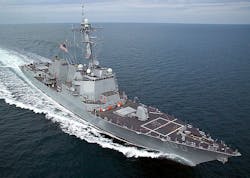Navy orders two Burke-class destroyer warships from two manufacturers in deals worth $1.24 billion
Officials of the Naval Sea Systems Command in Washington on Friday announced a $642.6 billion contract modification to General Dynamics Bath Iron Works in Bath, Maine, and a $602 billion contract to Huntington Ingalls Industries Inc. in Pascagoula, Miss., to build one destroyer apiece.
The DDG 51 multi-mission guided missile destroyer operates in support of carrier battle groups, surface action groups, amphibious groups, and replenishment groups, providing anti-submarine (ASW), anti-air (AAW) and anti-surface (SuW) capabilities.
The ship's combat capabilities revolve around the Aegis combat system, the SPY-1D multi-function phased-array radar, and the Mk-41 Vertical Launch System.
Related: Raytheon to provide networked sensor processing for newest Burke-class destroyer
Designed for survivability, the ship incorporates all-steel construction and has gas turbine propulsion. The ship also has two SH-60 helicopters, advanced anti-aircraft missiles, and Tomahawk anti-ship and land-attack missiles.
A Burke-class destroyer is 509 feet long with a 66-foot beam. It weighs 9,300 tons and takes about four years to build. The ship has four gas turbine engines that can propel the ship forward at speeds faster than 30 knots.
These ships provide multi-mission offensive and defensive capabilities and can operate independently or as part of carrier strike groups, surface action groups, amphibious ready groups and underway replenishment groups. They have a crew of more than 350 sailors.
Related: Navy orders as many as five Burke-class destroyers in potential $3.5 billion contract
In addition to its The ship's Aegis combat system and SPY-1D radar, the ship has two and Mk-41 Vertical Launch Systems, one 5-inch gun turret, two MK 32 triple-barrel torpedo mounts, and advanced sonar systems.
The first ship of the Arleigh Burke class, DG 51, was commissioned on July 4, 1991, and since then the ship has been recognized as one of the Navy's most successful surface shipbuilding programs. Sixty ships of the class have been built by Bath Iron Works and Huntington Ingalls.
The DDG 51-class ship is named for Adm. Arleigh Burke, one of the Navy's most famous destroyer squadron combat commanders, and three-time chief of naval operations.
Related: Blog: Navy's newest destroyers evolve to fill traditional battleship roles
On these contracts, Bath Iron Works and Huntington Ingalls will do the work in Bath, Maine; Pascagoula, Miss.; Cincinnati; Walpole, Mass.; Camden, N.J.; South Portland, Maine; York, Pa.; Charlottesville, Va.; Coatesville, Pa.; Erie, Pa.; and other locations, and should be finished by July 2023.
For more information contact General Dynamics Bath Iron Works online at www.gdbiw.com, Huntington Ingalls Industries at http://ingalls.huntingtoningalls.com, or Naval Sea Systems Command at www.navsea.navy.mil.
